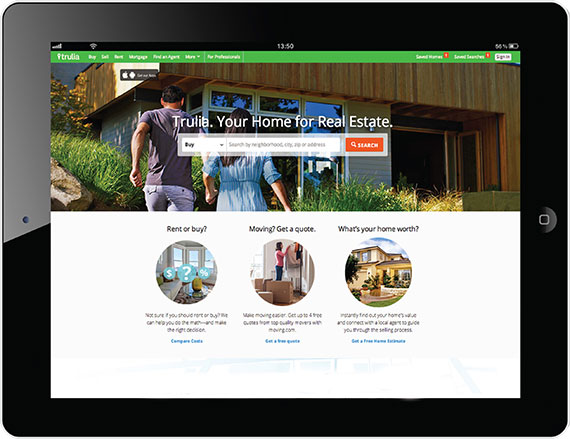Both veteran real estate companies and well-funded newcomers are scuffling over listings websites, each aiming for an acquisition that will provide new streams of revenue, as well as access to more comprehensive data.
Rupert Murdoch’s News Corp made the latest strategic offensive by acquiring the company Move Inc., owner of Moving.com and Realtor.com, which is backed by the National Association of Realtors. The deal followed CoStar snagging rental listings site Apartments.com in April, and Zillow announcing in July its plan to buy Trulia in a $3.5 billion blockbuster deal that would make it the largest operator of real estate for-sale listings, just a year after buying New York-focused StreetEasy.com for $50 million.
In August, Realogy, which owns the brokerages Coldwell Banker Real Estate, Sotheby’s International Realty and ERA Real Estate, along with Big Apple-centric Citi Habitats and the Corcoran Group, announced that it will launch two listings portals to cut down on its dependence on leads from Zillow, Trulia and Realtor.com.
While the listings site battle is mostly unfolding on the national stage, there have been some signs of change in the New York listings market, largely stemming from the acquisition of StreetEasy. The site is capitalizing on its new ownership by targeting a consumer audience, increasing accessibility and developing its mobile functionality. And consequently, Zillow has gained important access to the rental market through its new subsidiary.
The New York effect
At the time of its acquisition, StreetEasy.com was drawing 1.2 million unique users each month and had replaced the New York Times, Craigslist and other sites as the go-to real estate listing website in the Big Apple.
 “StreetEasy really cracked the code in New York City,” said Susan Daimler, general manager of StreetEasy and vice president of Zillow New York. “We want to continue to build out our comprehensive database to have more data to give consumers a better idea what it is to rent, buy and sell properties in New York City. One of the main ways we do this is to focus on mobile.”
“StreetEasy really cracked the code in New York City,” said Susan Daimler, general manager of StreetEasy and vice president of Zillow New York. “We want to continue to build out our comprehensive database to have more data to give consumers a better idea what it is to rent, buy and sell properties in New York City. One of the main ways we do this is to focus on mobile.”
Prior to the acquisition, StreetEasy’s mobile offerings were sparse. Since then, it did away with its insider subscription and now allows free access to drive more traffic and offer more “featured listings.” It has seen page views leap 150 percent in the year since mobile launched, Daimler said. And its mobile platforms — there are five of them, for different devices — have driven agent contacts up 170 percent this year , she said.
“I don’t see buyers using anything other than Street-
Easy,” said Brian Morgan, an agent with Citi Habitats. “But most brokers still are getting properties from their proprietary systems, which is fed from the RLS.”
As big as the deals are involving Trulia and Zillow, or News Corp. and Move, neither mean much yet for New York’s brokerage community, mostly because those sites have a limited presence in the market. “Anything that has to do with Realtor.com doesn’t affect us, because we use REBNY,” said Karla Saladino, founder and managing partner at Mirador Real Estate and a board member of Nestio, a third-party database that feeds into the RLS, the REBNY-backed platform that feeds most brokers’ databases. “We find national sites don’t account for much traffic.”
However, Zillow’s takeover of StreetEasy did seem to cause one marked change in New York’s RLS. During the summer, REBNY announced it will adopt the Internet Data Exchange, or IDX, so potential renters and buyers no longer have to register to access listings through its RLS data platform, a process that brokers said often turned off consumers. Many in the industry believe the move is a direct result of Zillow’s acquisition of StreetEasy, a much more consumer-friendly site, though REBNY said the change was part of its continuing efforts to provide the latest technology. Either way, “REBNY is catching up,” said Saladino.
Rentals: the Holy Grail?
The StreetEasy acquisition also allowed Zillow to get a foothold in New York rentals, which house two-thirds of the city’s residents. Daimler emphasized that rentals continue to be a focus as the company works on building its rental audience and improving the quality and quantity of rental listings.
For example, there have been instances of smaller brokers falsely listing an exclusive rental as their own, said Andrew Sacks, an agent with Citi Habitats. StreetEasy only accepts exclusive listings. “It’s hard to regulate every listing on there to validate whether it’s an agent-exclusive listing or a fake ad to lure people in,” he said.
Some rental brokers don’t necessarily depend on StreetEasy to find potential apartments for their clients, often preferring their own in-house databases fueled by the RLS, but they don’t ignore the site, either, and use it as a backstop. For others, the site is a big rental moneymaker. Saladino said that 40 percent of her brokerage’s deals come through StreetEasy. Her firm represents 20 building owners.
This is important for Zillow, which has made strides in the last year in growing its listings of single-family homes for rent nationwide, even though landlords are typically hesitant to spend large amounts of money on marketing, especially in low-vacancy markets like New York, according to Bradley Safalow, founder and CEO of PAA Research, an investment research firm.
That hasn’t dissuaded Zillow, yet. In June, it released its Zillow Rent Connect platform, which helps marketers of multi-family properties find renters. The next month, Zillow announced its partnership with RealPage, a property management software provider, to connect multi-family owners with potential residents.
It faces a new competitor in the space from the commercial real estate database CoStar, which bought the consumer-facing site Apartments.com in March for $585 million. It hopes to leverage its existing relationships with multi-family owners to make a meaningful play in the rental listings market. All have to contend with well-established Internet listing services, along with potential new players in the rental space, like News Corp. and Move, for a market that is considerably smaller than the for-sale one. New York is just one piece of that.
“It’s a really interesting time. The space is growing, so companies are looking for opportunities within that space,” said Daimler. “Companies are filling in gaps that they don’t have, which is what happened with StreetEasy.”
Advertising fees
Nationally, real estate brokers and their companies voiced concerns that advertising fees will increase if the Zillow-Trulia merger goes through, which makes News Corp’s deal and Realogy’s new venture more attractive, because they are backed by the NAR and brokerage firms themselves. Again, locally, the biggest changes come from Zillow’s StreetEasy, which has moved toward advertising and marketing as its source of revenue instead of subscription-based revenue.
There are millions of consumers looking to buy a home and millions more in the rental market, Safalow noted. “What I expect to see is a heavy emphasis on grabbing consumer mind share.”
Behemoth vs. behemoth
News Corp’s $950 million acquisition of Move — representing a 37-percent premium over the closing price of Move’s stock on Sept. 29, the day before the deal was announced — provides the publisher with more advertising revenue thanks to Moving.com’s and Realtor.com’s access to more than 800 multiple listing sites across the U.S. This will be a boost to New York-based News Corp., which was split off from 21st Century Fox last year.
 This is not new territory for News Corp, either. The company owns a majority stake in REA Group, which owns and operates the largest real estate and commercial listing sites in Australia, along with other international property advertising websites.
This is not new territory for News Corp, either. The company owns a majority stake in REA Group, which owns and operates the largest real estate and commercial listing sites in Australia, along with other international property advertising websites.
That deal puts even more pressure on the $3.5 billion deal between Trulia and Zillow to close. The Federal Trade Commission is reviewing how the merger could affect competition. Trulia and Zillow, which in June lured nearly three-quarters of all unique visitors to its network of real estate sites, which include Yahoo Homes, AOL Real Estate, HGTV’s FrontDoor, HotPads and MSN Real Estate, were basically forced to the altar by shareholders who were sick of the two companies spending exorbitant amounts of money on marketing, Safalow said.
But slower growth may be ahead. In fact, despite record revenue in the third quarter, Zillow issued a fourth-quarter revenue forecast last month that fell short of what analysts were expecting. Safalow noted that the volume of new traffic from homebuyers that Zillow and Trulia could attract is minimal because of the pair’s near-dominance in that market. Additionally, Zillow’s available advertising inventory is shrinking, largely due to the deals it has made with large brokerages, such as the featured listings marketing deal made with Douglas Elliman Real Estate in June. Then, there’s the stronger threat from Realtor.com and Moving.com, which may force Zillow, with or without Trulia, to continue its costly marketing spree.
“The perception is that Zillow is running over the brokers,” Safalow said. “But at this point, the brokers have negotiated terms with Zillow that are really attractive.”

